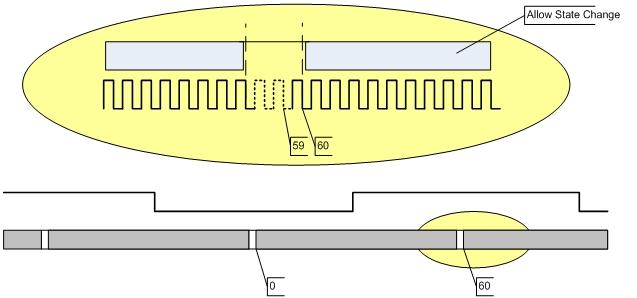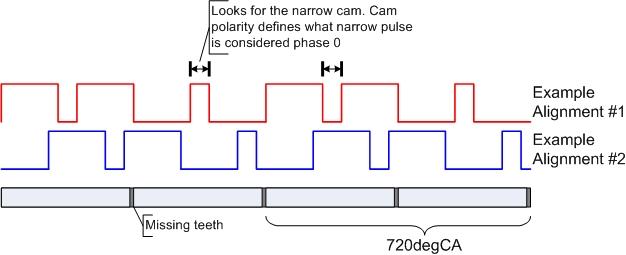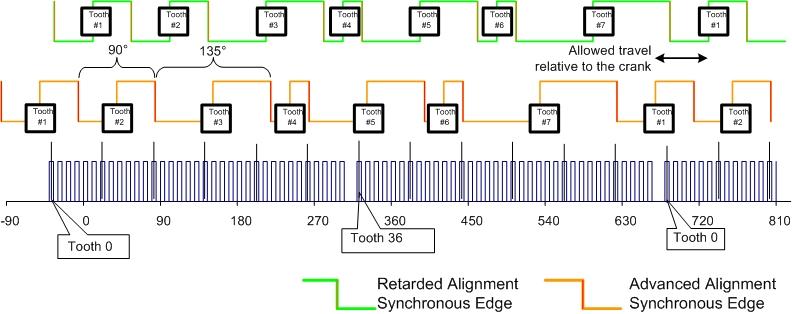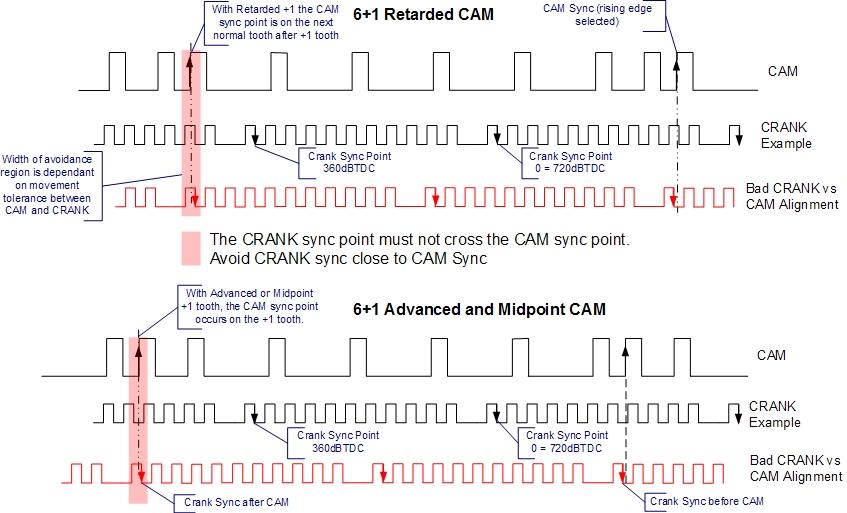Engine Controls Application Notes: Difference between revisions
| (One intermediate revision by the same user not shown) | |||
| Line 1: | Line 1: | ||
==How Smart Coil Works with MotoHawk's Ignition Ouput== | ==How Smart Coil Works with MotoHawk's Ignition Ouput== | ||
| Line 23: | Line 22: | ||
These patterns can be selected by going to the Motohawk Encoder Definition block as shown in the picture below: | These patterns can be selected by going to the Motohawk Encoder Definition block as shown in the picture below: | ||
[[Image:mh_block.JPG]] | [[Image:mh_block.JPG]] | ||
==Is Variable Valve Timing (VVT) supported in MotoHawk? == | |||
Yes, on the Freescale 55XX platforms, starting with release 2012a Beta 4 via Flexible Encoder | |||
==N Teeth with X Missing Encoder Style== | ==N Teeth with X Missing Encoder Style== | ||
Latest revision as of 00:41, 5 June 2012
How Smart Coil Works with MotoHawk's Ignition Ouput
The battery (coil supply) voltage, engine speed, engine load, and air/fuel ratio are taken into account in determining both the proper spark timing and needed coil dwell. These calculations are generally made in the base software time frame and are updated by default at 200 Hz, regardless of engine speed.
Once proper timing and dwell are determined for a given engine condition, a request is sent to the TPU for execution as a single pulse output for a given cylinder, cylinder pair, or distributor, where the rising edge 5-volt signal level pulse is sent to a high impedance devise (Smart Coil). The pulse energizes a transistor in the Smart Coil to turn on its primary. The 5-volt signal is then timed to stop energizing the primary and force the spark on the falling edge of the control signal as it de-energizes the transistor, forcing the coil energy to discharge through the secondary.
The output of the ECM is an on/off signal with no modulation for current control. There is no feedback to the ECM for primary or secondary coil current as the property of the coil determines energy storage from how long it is energized, as based on the supply voltage and coil inductance. For supply voltages and coil impedance used, the inductance of the coil is such that the coil current does not saturate for the dwell times (angle) we specify. Thus there is no need to measure current as it can be calculated quite accurately if needed. The only failure in current is total (all or none) resulting in a correct spark or total misfire, which can also be detected.
How quickly does MotoHawk Start an Engine during Crank?
The engine should start 2 revolutions from receipt of crank pulses. Some patterns can sync within 1 revolution.
What Encoder Patterns are Supported in MotoHawk?
MotoHawk™ supports a variety of crank and cam encoder patterns that continues to grows with each release. The following comes from MotoHawk version 2010a SP 0. Note, not all of these patterns are available on both the 55XX and 5XX Platform. Please contact New Eagle Sales to confirm your application.
These patterns can be selected by going to the Motohawk Encoder Definition block as shown in the picture below:
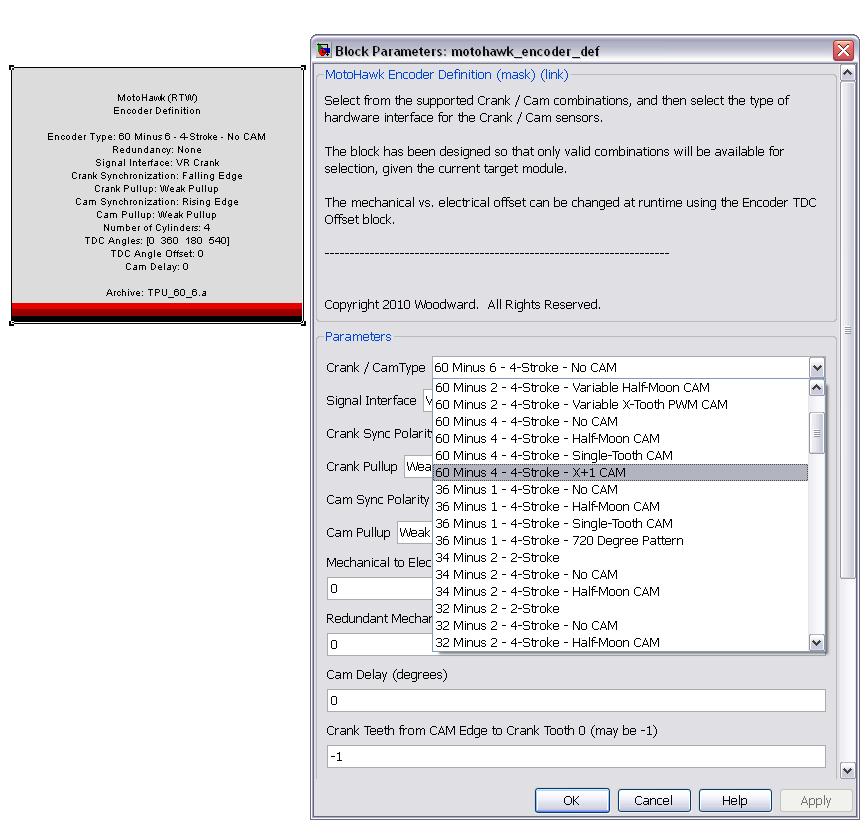
Is Variable Valve Timing (VVT) supported in MotoHawk?
Yes, on the Freescale 55XX platforms, starting with release 2012a Beta 4 via Flexible Encoder
N Teeth with X Missing Encoder Style
General Description
The N teeth with X missing encoder style describes those encoder patterns that consist of N equidistant teeth distributed about a wheel with X adjacent teeth then removed. The most common form of this pattern is the "N minus 1" and "N minus 2" patterns. The 60 minus 2, sometimes known as 58X is a member of this encoder style as is 36 minus 1.
Synchronization
The missing teeth are used to communicate synchronization information. Speaking generally, a single missing tooth is detected if a synchronous crank encoder edge is not detected within 1.5 times the previously observed tooth period. If there were two missing teeth then the multiplicand is 2.5 times the previous period.
A crank synchronization error will be flagged if the correct number of missing teeth have been observed without having observed the correct number of real teeth. Thus the 60 minus 2 pattern would issue a synchronization error if two missing teeth were observed without having previously observed 58 physical teeth.
A resynchronization can temporarily impact the behavior of crank-synchronous blocks. Impacts include a pulse not scheduling as expected, having it occur twice, or being malformed. The system will recover, but the initial impact is unavoidable because the correction to the crank angle position results in a step change in position that may disrupt the underlying pulse scheduling software.
Tooth and Halfmoon Cams
Cam No Go Region
The Tooth Cam and the Halfmoon Cam are both considered to be of tooth cam style. Neither edge of the halfmoon cam nor the synchronous edge of the tooth cam should fall within the missing tooth region for all engine operating conditions. Unreliable crank encoder synchronization may occur (which will lead to encoder errors) if an edge transition were to occur within this region.
No go region for the 60 Minus 2 (58X) Encoder
Halfmoon Cam Width Tolerance
The width of a half moon cam should approximate 360 crank angle degrees. That is, a cam edge should be observed approximately every 360 crank angle degrees. The tolerance will vary depending upon the number of teeth in the system. For a 60 tooth crank encoder, consecutive cam edges shall be:
- at least 330 crank angle degrees apart, and
- no more than 390 crank angle degrees apart
Utilizing a Tooth Cam configuration in place of the halfmoon will still allow a fully featured crank-synchronous model to be developed. Therefore a Tooth Cam can be used in place of a halfmoon cam if there is an issue with the width. Cam errors will be reported if a halfmoon is in use that does not conform to the width restrictions.
Halfmoon Cam Sensor Assumptions
The halfmoon cam arrangement assumes that a zero speed sensor is in place. Such a sensor is able to reliably report the presence or absence of metal with minimal to no rotation. A halfmoon should be treated as a tooth cam if such a sensor is not available.
Crank Teeth from Cam Edge to Crank Tooth Zero Setting
The crank teeth from cam edge to crank tooth zero setting is used to assist ControlCore in making an informed guess as to what the half cycle state is when it first observes missing teeth. Correctly setting this value will improve start quality. The setting is ignored when it has a value of -1. Instead ControlCore determines an appropriate value that won't be optimal. A positive value implies that the setting is to be used and communicates to ControlCore the number of crank encoder teeth that need to be observed from speed zero before the system can categorically conclude whether the cam edge would have been observed if it was going to occur prior to the observed missing teeth.
The figure illustrates a setting of 3 teeth. If at least 3 teeth had been observed before the first missing tooth is observed (from speed zero) and a cam tooth has not been observed then the system knows that the detected missing tooth corresponds to the half-cycle that does not have the cam tooth. The system can't make that assumption if 2 or fewer teeth had been observed before the first missing tooth.
Duramax Cam
Duramax Topology
The duramax cam consists of three pulses distributed about two engine revolutions. ControlCore uses the narrow pulse widths depicted by the figure as half-cycle markers. The width of these pulses are defined as the number of teeth in an engine revolution divided by 8. Thus for a 60 tooth crank encoder the narrow width could be no wider than 7 crank encoder teeth.
Duramax Cam Alignment
The cam may have any alignment with the crank encoder provided the edge that completes the narrow width does not fall within the missing tooth region and that exactly one narrow width resides in each half-cycle.
Count the number of teeth from the start of the narrow width until the missing tooth region to calculate the Crank Teeth from Cam Edge to Crank Tooth Zero setting.
Duramax Cam Sensing Technologies
The cam uses pulse width to determine the half-cycle marker and as such must utilize a sensing technology that will accurately convey pulsewidth information. Thus this cam pattern does not support variable reluctance (VR) sensing.
Coyote Cam
Coyote Topology
The coyote cam consists of 8 pulses of varying widths. ControlCore looks for a sequence of widths in order to provide half-cycle synchronization information to the crank encoder.
Coyote Cam Alignment
Cam alignment is restricted to the range dipicted in the figure. Set the Cam Sync Polarity to match the figure. Coyote Cam Sensing Technologies
The cam uses pulse width to determine the half-cycle marker and as such must utilize a sensing technology that will accurately convey pulsewidth information. Thus this cam pattern does not support variable reluctance (VR) sensing.
X+1 Cam
X+1 Topology
The X+1 CAM compares the widths between CAM teeth to detect a narrow width + 1 pulse advanced or retarded within normal CAM teeth. The presence or absence of the +1 CAM tooth provides half-cycle synchronization information to the crank encoder. Normal CAM teeth are the equally spaced teeth. The +1 tooth occurs once per cycle within the same normal tooth pair.
X+1 Cam Alignment
If the CAM sync point is on or can move either side of the CRANK sync then encoder errors will occur, and TDC will move by 360degrees
MPC5xx module specific limitations
There must be at least two REAL (not missing) CRANK synchronous edges between any two CAM pulses.
- Encoders with 1 or 2 missing teeth: The CRANK Sync point is located between the last missing tooth and the next real tooth.
- Encoders with 3 or 4 missing teeth: The CRANK Sync point is located on the 1st real tooth after the missing.
Prosak Manual
The Knock detection on the ECM-5XX (48, 80, 128) uses the Motorola Prosak IC. The application / programming manual is available to customers upon request.





